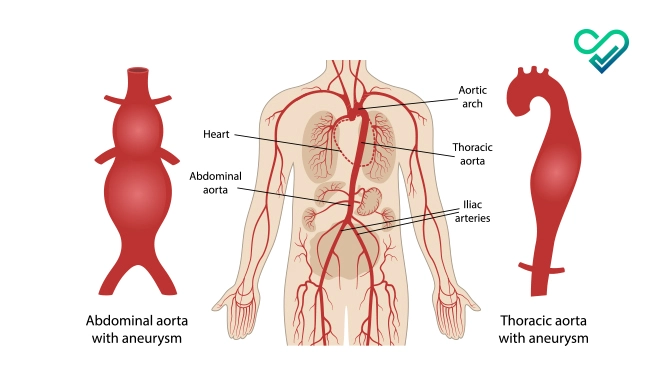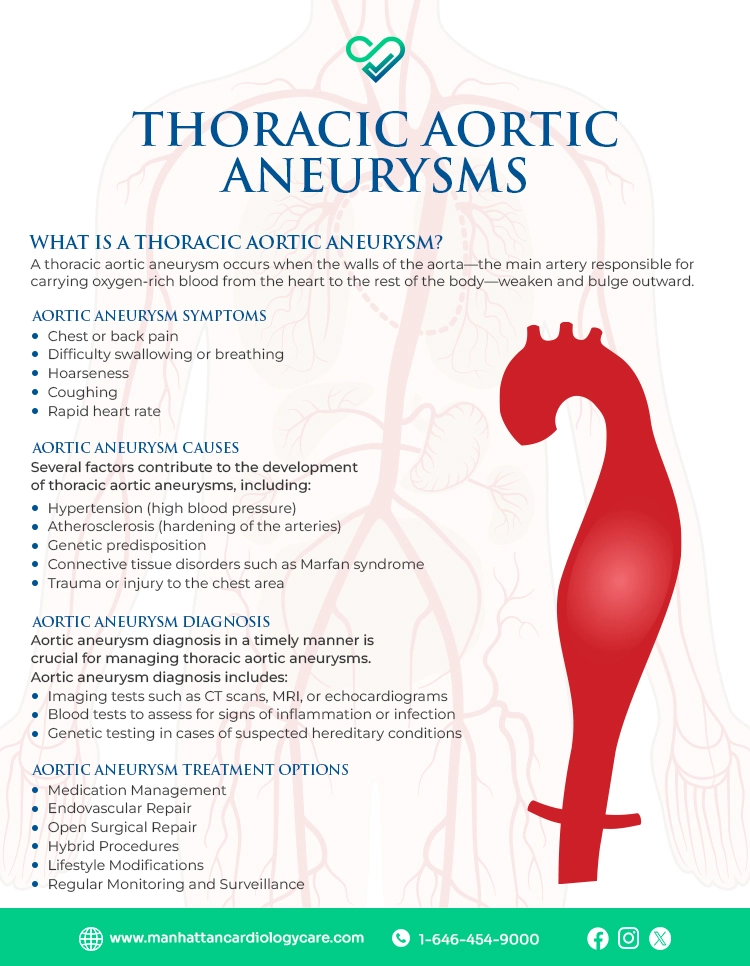Have you ever wondered about the silent dangers that are present within your body, unnoticed until it’s too late?
Imagine a ticking time bomb, quietly expanding in your chest, threatening to rupture without warning. This ominous presence is known as a thoracic aortic aneurysm, a condition that demands attention and understanding.
Let’s get into the details of this potentially life-threatening ailment.
Table of contents
What is a Thoracic Aortic Aneurysm?
A thoracic aortic aneurysm occurs when the walls of the aorta—the main artery responsible for carrying oxygen-rich blood from the heart to the rest of the body—weaken and bulge outward.
This bulge can develop anywhere along the portion of the aorta that runs through the chest cavity, hence the term “thoracic.” If left untreated, these aneurysms pose a severe risk of rupture, leading to catastrophic consequences.
How Common are Thoracic Aortic Aneurysms?
While not as prevalent as other cardiovascular conditions, thoracic aortic aneurysms are not quite uncommon. According to recent studies, they affect approximately 10 in every 100,000 people annually. Although the incidence rate may seem low, the potential ramifications necessitate vigilance and awareness.
What are the Aortic Aneurysm Symptoms?
Thoracic aortic aneurysms are notorious for their stealthy nature, often remaining asymptomatic until a rupture occurs – However, some individuals may experience warning signs such as:
- Chest or back pain
- Difficulty swallowing or breathing
- Hoarseness
- Coughing
- Rapid heart rate
Aortic Aneurysm Causes
Several factors contribute to the development of thoracic aortic aneurysms, including:
- Hypertension (high blood pressure)
- Atherosclerosis (hardening of the arteries)
- Genetic predisposition
- Connective tissue disorders such as Marfan syndrome
- Trauma or injury to the chest area
What are the Risk Factors?
Certain demographic and lifestyle factors may increase the likelihood of developing a thoracic aortic aneurysm, including:
- Advanced age
- Male gender
- Smoking
- Obesity
- Family history of aortic aneurysms or related conditions
How Serious is a Thoracic Aortic Aneurysm?
The seriousness of a thoracic aortic aneurysm cannot be overstated. Without prompt aortic aneurysm diagnosis and intervention, the risk of rupture looms ominously, often resulting in sudden death.
Even if detected early, the potential complications, such as organ damage or stroke, underscore the gravity of this condition.
Aortic Aneurysm Diagnosis
Aortic aneurysm diagnosis in a timely manner is crucial for managing thoracic aortic aneurysms.
Aortic aneurysm diagnosis includes:
- Imaging tests such as CT scans, MRI, or echocardiograms
- Blood tests to assess for signs of inflammation or infection
- Genetic testing in cases of suspected hereditary conditions
Can You Prevent a Thoracic Aortic Aneurysm?
While certain risk factors may be beyond your control, adopting a heart-healthy lifestyle can mitigate your chances of developing a thoracic aortic aneurysm. Strategies include:
- Maintaining a healthy weight
- Quitting smoking
- Managing hypertension through diet, exercise, and medication
- Undergoing regular check-ups to monitor blood pressure and cholesterol levels
Aortic Aneurysm Treatment Options
Aortic aneurysm treatment options for thoracic aortic aneurysms depend on various factors, including the size and location of the aneurysm, as well as the patient’s overall health.
The aortic aneurysm treatment options may include:
- Medication Management:
Medications may be prescribed to control blood pressure and reduce the risk of aneurysm rupture. This typically involves the use of beta-blockers or other antihypertensive drugs to lower blood pressure and decrease the force on the weakened artery walls. - Endovascular Repair:
Endovascular repair, also known as endovascular stent grafting, is a minimally invasive procedure where a synthetic graft is inserted into the damaged portion of the aorta through small incisions in the groin. This graft reinforces the weakened area and redirects blood flow, reducing the risk of rupture.
- Open Surgical Repair:
In cases where endovascular repair is not feasible or appropriate, open surgical repair may be necessary. This involves a more traditional surgical approach, where the damaged section of the aorta is replaced with a synthetic graft through a larger incision in the chest.
- Hybrid Procedures:
Hybrid procedures combine elements of both endovascular and open surgical techniques. For complex aneurysms that extend into the arch of the aorta or involve branching vessels, a hybrid approach may be employed to achieve optimal results.
- Lifestyle Modifications:
In addition to medical and surgical interventions, lifestyle modifications play a crucial role in managing thoracic aortic aneurysms. Patients are advised to quit smoking, maintain a healthy weight, and adhere to a heart-healthy diet low in saturated fats and sodium. - Regular Monitoring and Surveillance:
Regardless of the chosen aortic aneurysm treatment approach, regular monitoring and surveillance are essential to track the progression of the aneurysm and assess the effectiveness of aortic aneurysm treatment. This typically involves periodic imaging studies such as CT scans or MRI to evaluate the size and stability of the aneurysm over time.
– Disclaimer –
This blog is for informational & educational purposes only, and does not intend to substitute any professional medical advice or consultation. For any health related concerns, please consult with your physician, or call 911.


